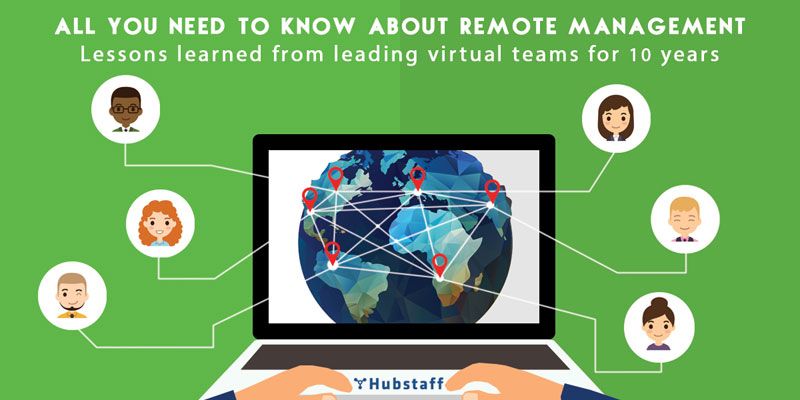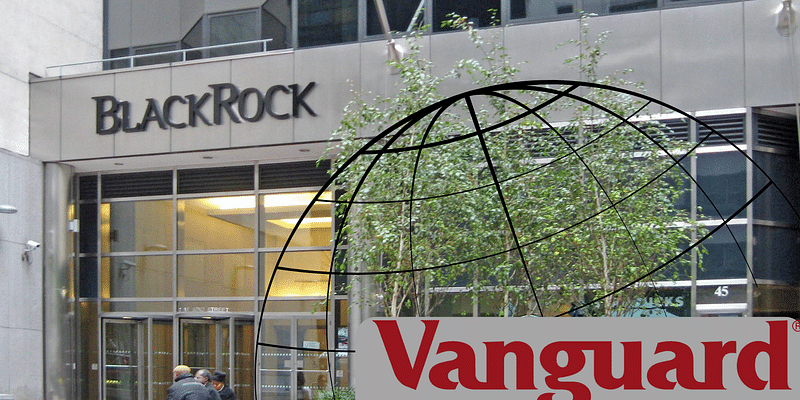What I’ve learned from 10 years of remote team management
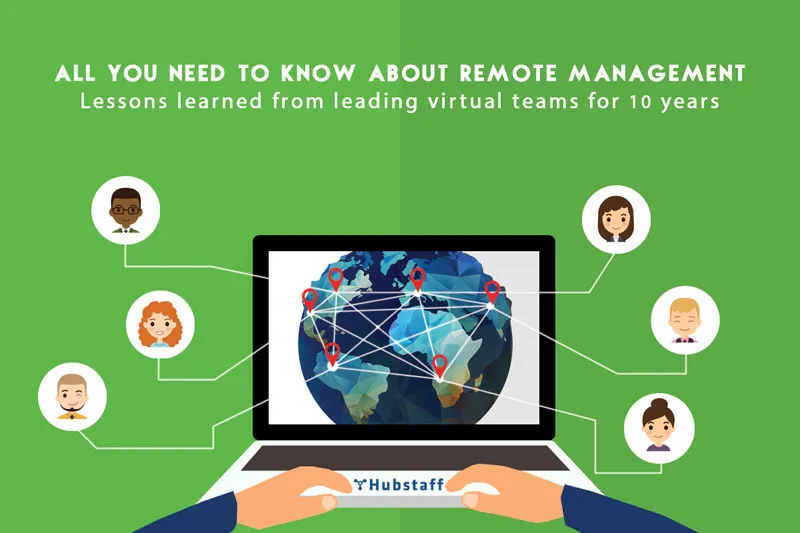
Team management is not a skill that comes naturally to most people. It has to be learned, and there are usually plenty of mistakes made along the way. In my case, I fumbled around for about 10 years, lost a bunch of money, and eventually founded Hubstaff to automate the proven processes that I had developed, which had worked very well. This article goes over the management methods that work for my remote teams, but it can be applied to co-located team management as well.
Team management is the most important aspect in business for the following three reasons:
- You can’t build a successful company alone. Once you start growing, how your team operates will inevitably define the success of your company.
- The goal of any business is to create an organization that can produce income for you, whether you are actively working in the business or not. You can never create that business without an awesome team.
- Your team is usually the most expensive line item on a P&L. Hubstaff spends around 30k a month on labor and brings in around 50k – that means that 60% goes directly to labor costs. That does not include anything the founders take. This is important because it’s easy to overspend and “waste” here just like any other P&L line item, but since it’s generally a larger number your processes are all the more important.
The best part about this process is that both my team and I like it. If you want to read the complete 70-page book on how we manage you can get it here for free. Before I get into the exact process, here are some fundamentals to help put a framework around the process and allow you to understand it at a deeper level.
The Fundamentals of Team Management
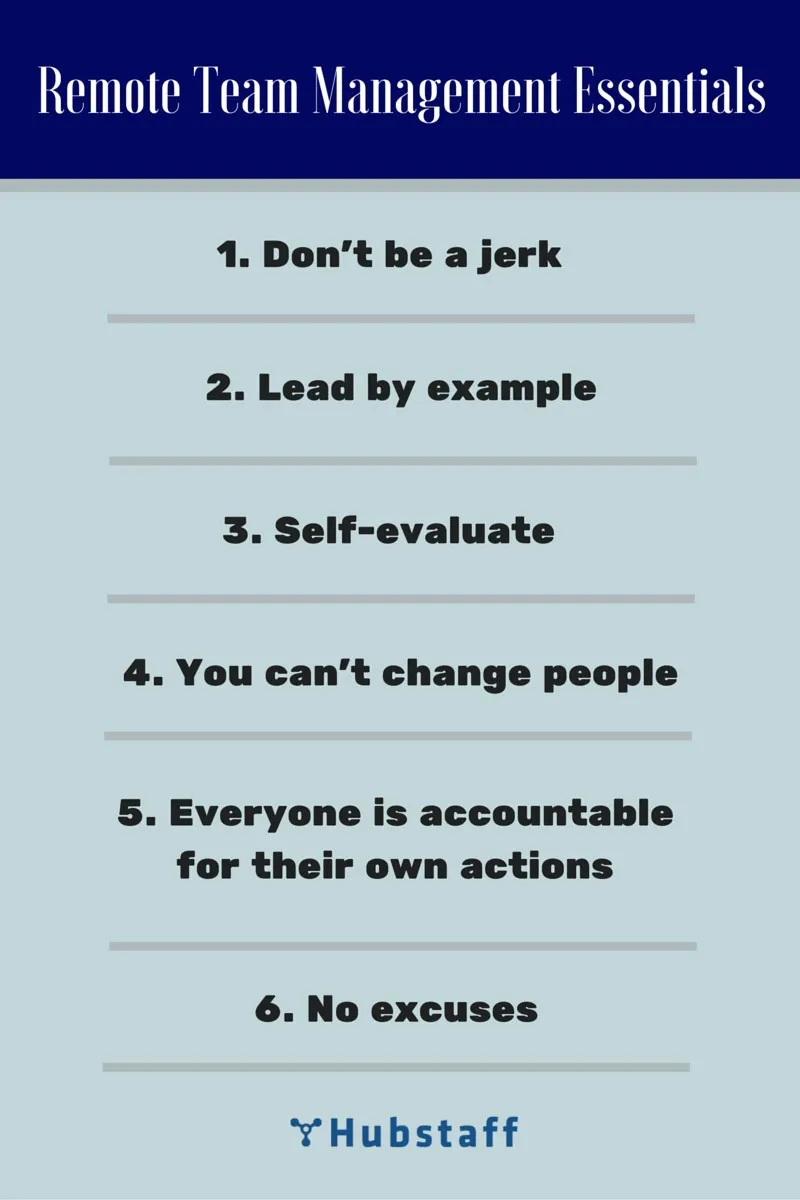
1. Don’t be a jerk
It’s not needed, and it doesn’t get results. It makes you look like you’re unhappy and unhappy people are generally a pain to be around.
2. Lead by example, and expect people to get the hint
If they don’t, then clarify your expectations. If they still don’t get it, let them go nicely.
3. If there’s a problem with a person, look in the mirror first
Quite possibly, you are expecting too much or you have not done your job as a manager to outline the work closely enough. Your team most likely needs a blueprint unless they have high-level experience and work styles.
4. You can’t change people
You can teach people, if they want to be taught, but you can’t change people.
5. People need to be accountable for their own actions
It’s up to you to find and hire people that are accountable and responsible.
6. No excuses for work
It’s either done or it’s not. It’s either quality or it’s not. If you want your employees to embody this, you have to teach by example and establish a no excuses policy.
There are times when important things don’t get done even though the employee is working hard, and this usually results from a miscommunication. Everything in a company is a matter of priorities. If task A is not done, chances are something else took higher priority. You’ve got to find out what that was and adjust.
On General Management Style
Hubstaff’s general management style is very much in favor of autonomy, freedom, and letting people show us how they can fit in on our team. We’re meeting-averse, and our time tracking software lets us get away with that. https://twitter.com/intent/tweet?text=We%E2%80%99re%20meeting-averse%2C%20and%20our%20time%20tracking%20software%20lets%20us%20get%20away%20with%20that.&via=hubstaff&related=hubstaff&url=http://blog.hubstaff.com/perfecting-team-management/

Hubstaff allows us to quickly check up on our teams, see what they’ve been working on, for how long, and where they are with deliverables. It frees the entire team from time-consuming meetings and is beneficial for everyone from managers to contractors. We prepare all our team members for it in onboarding, and then we give them the freedom to work on their tasks and show us their aptitudes for different kinds of work. Since they don’t bill for unproductive time, we can focus instead on creating healthy processes of communication and rewarding productivity instead.
Other remote entrepreneurs might feel the need to check in more and actively manage their teams, but our employees love the freedom of being able to devote most of their time to getting work done.
Our 9-Step Process for How To Manage a Remote Team
If you’ve read my book, No Excuses: The Definitive Guide to Building a Remote Team, then you understand that I believe in explaining the “why” behind everything. I’m going to practice what I preach in this post and explain why we complete the various steps that we take in the process.
Step 1: Decide on and set up a project management system
Because I have so many team members moving in different directions, I want to know who is doing what and when or it stresses me out. A project management system lets me do many things more effectively in my business.
- It allows me to capture ideas and things that the company needs to get done. The project management system is like my virtual brain. I unload my ideas there for processing later on, then I can continue drinking my beer, or whatever else I was doing when I had the idea.
- It allows me to efficiently assign tasks to my team while also keeping the tasks organized.
- It automates communication and discussion with my team and stores it in a centrally accessible place.
- It allows me to set priorities among tasks within a larger organizational framework.
- It allows for documentation of the task that needs to be done.
Our project management tools are my universal work organization system – they capture my thoughts and their progress in execution. In my mind this is an essential step, and any company not using these tools is seriously missing the boat. We use Trello for marketing and admin, and Pivotal Tracker for development.
Step 2: Get all tasks loaded into the project management software with priorities
Taking the time to upload information into a project management software is a good investment for your peace of mind. Having your information laid out helps you see what your project timeframes are and allows you to assign priorities within your business.
Remember that you can’t do everything, and sometimes more is less for the good of your business. In Hubstaff, I’ve organized lists in Trello for each “channel” in my marketing arsenal. For example, everything that should be done for social media goes under one master “Social Media” list in Trello.

Step 3: Assign 3-4 projects or tasks to each member of your team.

Assign different team members to specific tasks and give them the responsibility for their tasks. Each card in our Trello board translates to one actionable item. The key to this process is being reasonable with timelines and making someone accountable for a task. Now the task is on their plate and not yours and that’s been communicated to them via the software. You can also assign multiple people to a task. https://twitter.com/intent/tweet?text=Make%20someone%20accountable%20for%20a%20task%20by%20giving%20them%20ownership%20and%20documenting%20the%20hand%20off&via=hubstaff&related=hubstaff&url=http://blog.hubstaff.com/perfecting-team-management/
Step 4: Kill Email
Make sure the majority of communication within your team goes through your project management system. There are some people who are more comfortable with email and may fight you on the decision, but remain insistent and everyone will get used to it. Overall, it will be more efficient and organized. Information sent over email, Skype or Slack is poorly organized and documented, so those are not good channels for long discussions or instructions.
In Hubstaff, our team communicates on a specific Trello card. Then, any member who is mentioned or subscribed to the card will get an email directly in our inboxes with a Trello alert.

If a response is needed then we respond in Trello, not in Skype and definitely not via email. The beauty of this is that you get a nice documentation of each task in your organization. When all communication is done in one place, it’s also easy to tell if someone hasn’t been working on a task.
If one of our people emails me something about a task, my response is simply “Please add to Trello.” They learn after a while that I will not respond via email but I will respond via Trello.
Step 5: Start Tracking time to the assigned tasks
It’s impossible to know more than the superficial details of what’s going on in a remote business without time tracking. One time my best developer was spending 60% of his time on support, and I wouldn’t have known without time tracking. As a leader, I recognize that it’s up to me to implement time tracking and check to make sure my team is spending their time as efficiently as possible. The contractor never would have told me that he was spending 60% of this time on support and didn’t have enough time for development because I was the one who had stuck him on support to begin with, and he logically assumed that since I had given him a task, he needed to devote the amount of time necessary in order to do it well.
Since Hubstaff integrates with Trello, when a user on our team is assigned a card, that task then shows up in their Hubstaff tracker. They can then track time to that card. Here’s everything you need to know about Trello time tracking.
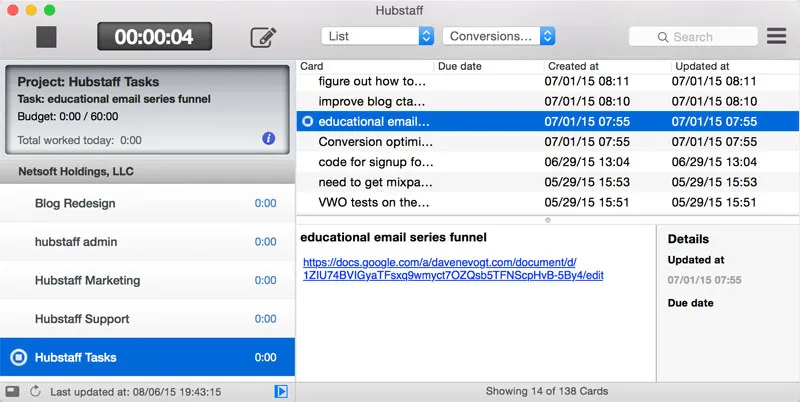
We require that everyone tracks time to Trello tasks they’ve been assigned to with Hubstaff. If they track the time they spend working, it’s easy for me to monitor the weeks and months to understand how long tasks are taking.
Tasks can be very specific or general. For instance, we don’t change tasks every time we answer a support question. When my team is working on support, they just track time on a general support card. That way, I can add up at the end of the month how much time support is taking. I can tell instantly if it’s time to hire another support employee or if their support workload is manageable.
Step 6: Set up Sprints
I typically have someone assigned to 15 to 30 cards in Trello, which is frankly too many to manage effectively. Even the most seasoned professional should only be thinking about three to five things at a time to remain effective, especially if it’s high level. It’s nice to have more than one item because it provides some flexibility in what you can do next.
We used to use labels in Trello, but now we use sprints to manage short-term items. Sprints make it undisputedly clear what the team needs to get done in the given week, and exactly what the priorities should be.
I have set up a specific sprint board for marketing that looks like this:
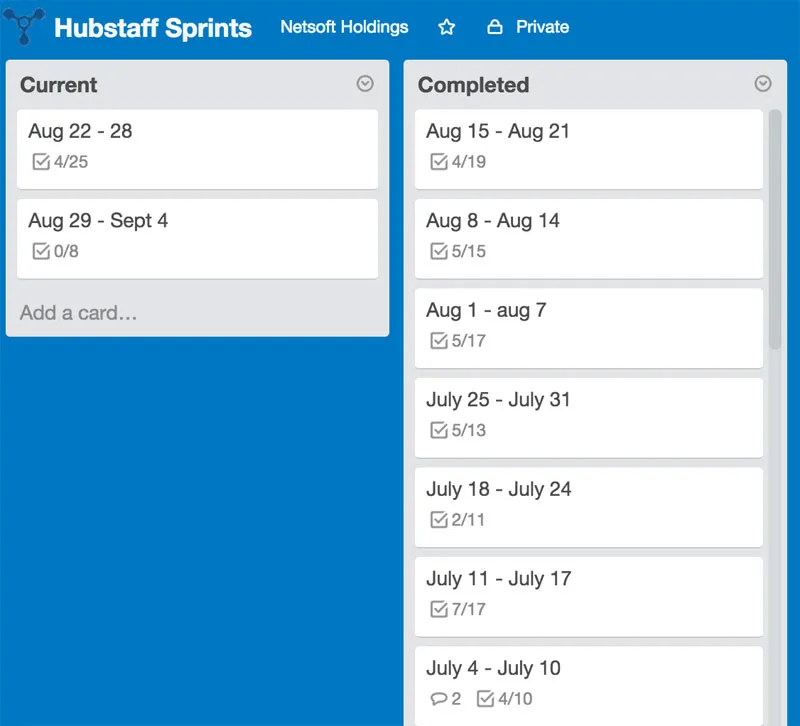
We’ve created an example template for you to copy and use in your own business as well.
Each sprint card has a checklist, which links through to the individual cards that need to be completed. There is no detail on the sprint board, it simply is for organization and links to specific cards where all the details live. Since I link to existing Trello cards it makes it very easy to find the specific Trello cards you should be working on.
I ask my team never to add or remove anything from the sprint list. The whole point of a sprint is to be very detailed and if the work doesn’t get done, then it should be explained.
I have my own work listed here as well for everyone to see.
In theory, these should be the only cards that are being worked on because they are what’s been identified as the most important items for the team. In reality, around 80 to 85 percent of time is devoted to them because of other issues that come up like customer questions, small support articles, and tasks that are too small to merit a sprint item.
I generally do this work in 20 minutes on a Monday. I inform my team that their sprint items for the week are up, and to let me know if they have any questions. Notice that I continually let them know that I am there for them and that I am willing and able to answer any questions they have.

Step 7: Work on the sprint items and watch them unfold
As time is tracked to the card, I can go into Hubstaff and see the work unfold in real time. What works best for my organizational style is to go to the reporting section and see where time is being broken down by person and by task. This saves me from having to email back and forth with people about what is getting done.
- As items get done, my team moves them to the delivered column in Trello, which sends an email notification to my inbox so I know it’s done. This keeps all records of completed work together in one place, and it saves them the trouble of writing me an email update.
- The next step is for me to quickly review their work, which I can compare alongside the task description and the record of communication on the task. When I’m satisfied that the task is done, I move it to the accepted column.
- In the meantime, I can log into Hubstaff at any point and see what’s going on and who’s doing what in real time. This is the virtual equivalent of walking around the office and checking up on your employees, only it’s much less intrusive. In an office, the employee usually has to stop what they’re doing and directly engage with the boss. At Hubstaff, they’re free to go on doing what they like.
Now if I’ve done my job as a manager, I’ve given good blueprints and descriptions within the Trello card itself. A good Trello card looks like this.

I generally link to Google Docs and supporting documents. Many of my people contact me through Skype or Slack at this point as well. If they need in-depth help sometimes a discussion is best. If I don’t respond, then they are trained to put that Skype message into Trello instead. It’s very important to me that if I am playing with my kids or out to dinner that I don’t need to stop everything that I am doing in order to respond to someone right at that instant. That’s why asynchronous communication is cool in a remote team when you are dealing with different time zones, sleep schedules, and optimal working times.
Step 8: Sprint Follow Ups
Just because someone knows what they need to do doesn’t always mean it’s actually going to get done. That’s why we look back and review sprint lists and ask people to explain why any items remained unfinished so that they can help give us valuable feedback on how well we’re managing them. For example, if one person continually misses deadlines, the cause is often that they’re getting distracted by something out of our control or simply by doing things that are not on the highest priority list of the company. We can find this out by the feedback we get.
All I have to do is send an email to my team asking them to give me an update on their sprint list. I do this on a Friday and they typically respond back on a Friday or over the weekend.

Tip: Instead of having sprint items that are multi-week projects you can break the project up into detailed things to get done for the week.
Step 9: Analyze where time is being spent
At the end of the month I can get a really good feel for what’s going on and where time is being spent. This is important for me so I can become a better manager for my team. If team members have sprint items to work on, but they are not doing them, it’s my job to correct that. Most likely it’s not a team member that’s the problem, but something broken in the work process. In this case, I would follow up directly with the team member and try to understand what’s going on. If they continue to be distracted by other items and don’t get their work done despite me doing everything in my power to help them, then it’s time to look for someone else.
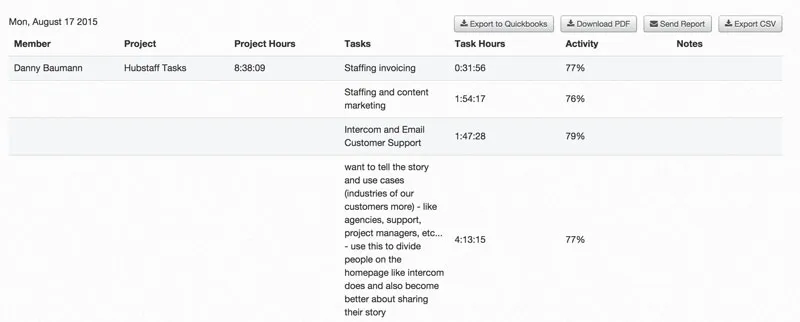
Some of the cool things you can do here are:
- Understand where each individual spent time during the past week / month / year and get a bird’s eye view of their overall career at your company.
- Understand how much time was spent on various clients and identify which are consuming more time versus creating more profit.
In Conclusion
Our team management process eliminates the need to have a ton of meetings and discussion. We do our work up front by documenting the processes and we communicate along the way to get tasks done. https://twitter.com/intent/tweet?text=We%20do%20our%20work%20up%20front%20by%20documenting%20processes%20and%20communicating%20along%20the%20way%20to%20get%20tasks%20done&via=hubstaff&related=hubstaff&url=http://blog.hubstaff.com/perfecting-team-management/
As the manager, my job is lessened drastically. I spend about 20 minutes on Friday following up with people on their sprints and about 20 minutes on Monday designing new items for the coming week’s sprint. These are the two large communication points I have with my team members. The rest is just answering questions, talking back and forth regarding the tasks, and contributing to conversations on Trello and Skype.
As the leader of the marketing department, it’s my job to be above the business and see the path ahead of us. I have to set the priorities of the company and my work is generally more high level, but I have relationships with each of the team members. The general idea is that my job is to oversee the entire organization and decide on our priorities and direction. The flow is; idea generation -> set priorities -> assign tasks making sure that documentation is in place -> get the work done -> rinse and repeat for forward progress.

This process freed up the time I need to go from a one-person, flat organization, to bringing on team members and developing them into managers. Now we’re working based on KPIs and I can let the manager take charge of communicating with the individuals on their team. This will allow me to think more strategically and spend more time developing processes, learning and scaling the business.
This process has been the most effective way that I have determined to manage my team both from my perspective and from theirs. If followed properly, you’ll have a business that runs pretty efficiently and is simply about moving the organization forward.
Anything I missed?
I hope this article helps you avoid some of the mistakes that I made and that it helps you learn something about remote team management from my experience. It’s been a great 10 years and counting.
If you’ve got any questions, thoughts or if you disagree with something I’ve said, let me know in the comments below. I love hearing from our readers and my team and I are always looking to improve the usefulness of these posts.
This post originally appeared on the Hubstaff blog and was written by Dave Nevogt, co-founder of Hubstaff. You can subscribe to their blog where Dave regularly shares valuable tips to manage a distributed team successfully.

About the Author
Dave Nevogt is the co-founder of Hubstaff and focuses on growth. Dave has founded several multi-million dollar businesses and lives in Indianapolis. He writes a blog series that teaches everything his team does to grow Hubstaff and free training on how to build a remote team
(Disclaimer: The views and opinions expressed in this article are those of the author and do not necessarily reflect the views of YourStory.)






